Badiul Zaman Jezri, a Muslim scientist and the father of robotics

 Badeel Zaman Jezari
Badeel Zaman JezariAn abstract of Badeel Zaman Jezri's biography:
Full name: Badi al-Zaman Abul Az bin Ismail bin Razzaz Jazari
Date of birth: 1136 AD
Place of birth: Ibn Omar Island
Profession: omniscient, inventor, mathematician, industrialist and mechanical engineer
Died: 1206 AD
Works: Al-Jama'i between science and useful work in the industry of al-Hayl
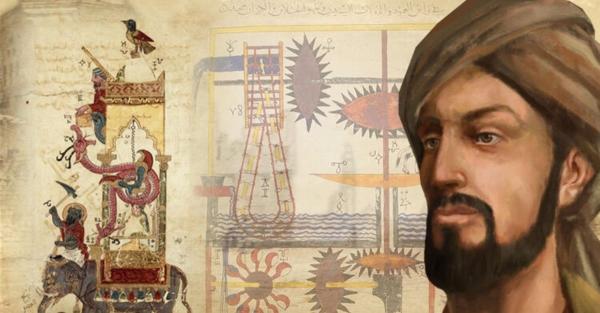 Biography of Badeel Zaman Jezri
Biography of Badeel Zaman JezriBiography of Badeel Zaman Jezri:
Badi al-Zaman Abul Az bin Ismail bin Razzaz Jazari was born in 136 AD on Ibn Umar Island in present-day Turkey. He was omniscient, an inventor, a mathematician, an industrialist and a master of mechanics. He is also known as the father of world robotics science, who had Kurdish origin.
The works of Badeel Zaman Jezri:
The most famous work of this scientist is al-Jamae bin al-'alm wa al-'alm al-nafa' fi sanaar al-hail, which was also published in Persian under the title of the theoretical and scientific foundations of mechanical engineering in Islamic civilization. This book was written in the year 602 AH by the order of Qara Arslan, Amir of the Artoglu Dynasty in Diyarbakir, Anatolia.
This book narrates how to work and make 50 devices, which include water and candle clocks, automatic dishes and fountains, water supply devices from streams and wells, automatic reed playing devices and other devices including code locks and cloned locks and geometric tools. . Most of the furniture and fittings that he describes in it were his own inventions.
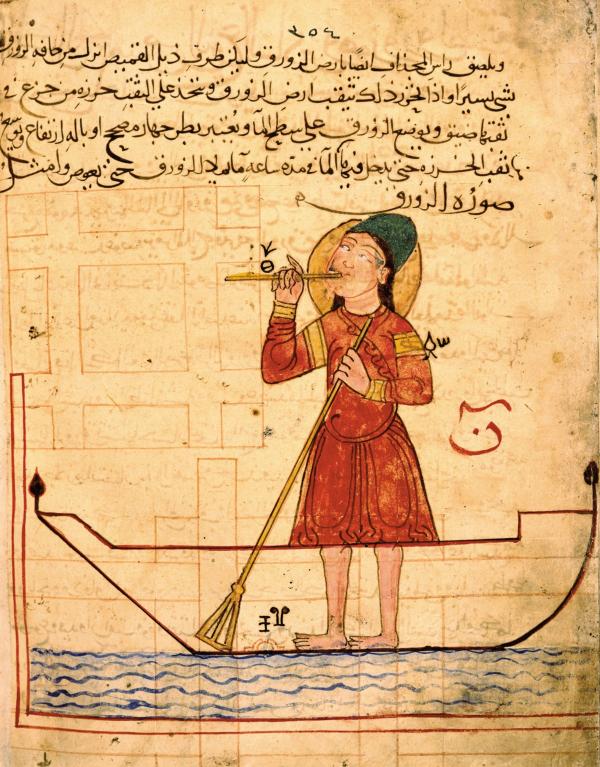 Badeel Zaman Jezri's biography
Badeel Zaman Jezri's biographyImportant inventions of Badeel Zaman Jezri:
Elephant Clock:
This complicated watch is one of the most innovative inventions of the Jezree era, which was built and produced in the 6th century of Hijri. The working method of this watch included 7 stages and had many complicated parts and worked with a water mechanism.
candle clock:
Engineer and translator of Islamic engineering works; Donald Hill states: Jezri designed the most complicated timepieces ever known. He says this about Al-Jazari candle clocks:
A candle whose degree of burning is known and there was a lid in its lower part. After passing through the hole, the wick is collected in wax, which can be replaced periodically so as not to disturb the burning process. The bottom of the pile is located in a shallow container and a ring next to it is connected to the balance weight through a roller. As the candle burns, its weight pushes it upward at a constant speed, which drives its mechanism from the bottom face of the candle. No other candle clock has been so advanced. The wax watch included a pointer to show the time and was the first to use a hand blade mounting mechanism, a mechanism still used in modern times.
In this type of watch, Jezri invented a spark plug, which is still widely used in the industry, and is called the Jezri connection, for the convenience of replacement. Flush fitting is widely used in lamps and wherever quick installation is required.
Castle hours:
The castle clock is considered to be the largest tidal astronomical clock, which has a complex mechanism and its height is about 3.4 meters. In addition to the time, this watch also has other functions, including the display of the zodiac and the solar and lunar orbits. The device has other innovative features that include a pointer in the shape of a crescent moon that moves from the top of the gate. The clock is carried by a hidden cart and its doors open automatically, then reveal a doll every hour.
Another innovative feature of this watch will be the possibility of planning the length of the day and night based on the changes that occur throughout the year. Among other features of the watch, there are five automatic musicians that play music automatically when the levers connected by hidden camshafts are moved.
Other components of this watch include a main tank with float, depression and valves, two pulleys, a crescent disc representing the zodiac, and two falcon balls in pots and gears.
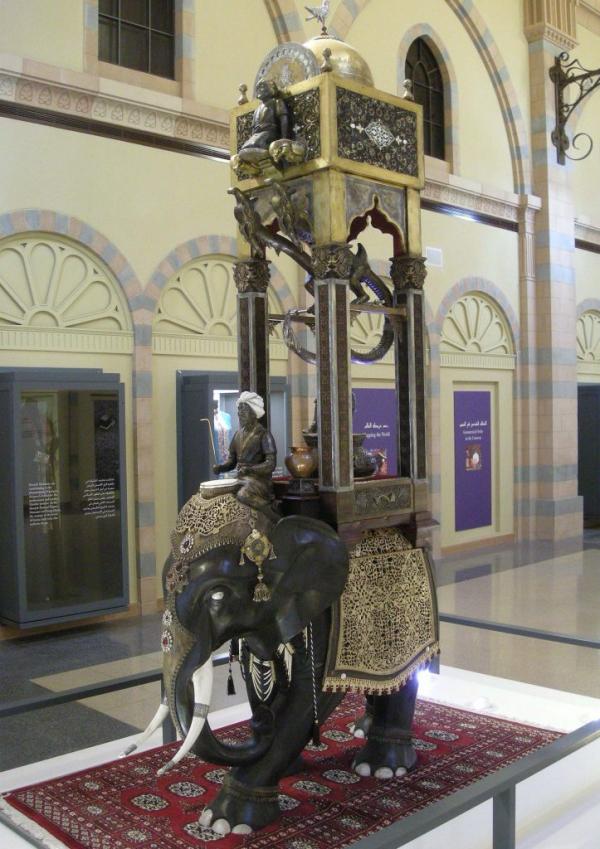 The castle clock is one of the most innovative inventions of Zazari
The castle clock is one of the most innovative inventions of ZazariTwo-hour clock:
According to Aldo Miili: Jezri made a blue clock that could show two different times with two hands at the same time.
Automatic device:
The first humanoid programmable robot was built by Al-Jazari at the end of his life, which made him known as the world's leading robotics engineer. His invention was a water boat in which four artificial musicians played music and entertained the audience for the ceremonies and programs of the royal celebrations, the instruments were hydraulically programmed with the help of water.
Beverage waiter:
Another tidal robot was a waiter who could serve water, tea or wine. The drink was stored in a mug from where the drink was put into the bucket and dripped into the cup after 7 minutes. After that, the waiter would come out of the automatic door and serve the drink.
Ablution machine with flush mechanism:
Al-Jazari also invented a hand washing machine that had a flush or siphon mechanism, this invention is now used in modern toilets. Flash Tank is another example of Al-Jazari robots, which has a copper human body and holds a peacock-like pitcher in its right hand.
The pitcher is made of brass and is placed in a chamber that is divided into two parts by a metal plate. This mechanism will help to pour water evenly from the opening. A tank in which water is stored
The right hand of the robot is located, and a shaft is installed in its right elbow so that the liquid comes out of the tank and the opening of the pitcher.
The left arm of the robot held the comb, the mirror and the towel and had a fixed weight that raised and lowered the arm.
This robot was invented for the Sultan to perform ablution before prayer, and the Sultan's servant was responsible for carrying it. Next to this robot was a basin that could hold liquid. In the next step, the servant turns a handle on the back of the robot, which opens a valve and water enters the pond from the right hand of the robot. When the tank was almost empty, a mechanism would sound and the left hand of the robot, which was holding a towel, a comb and a mirror, would reach out to the Sultan so that he could dry himself and brush his beard.
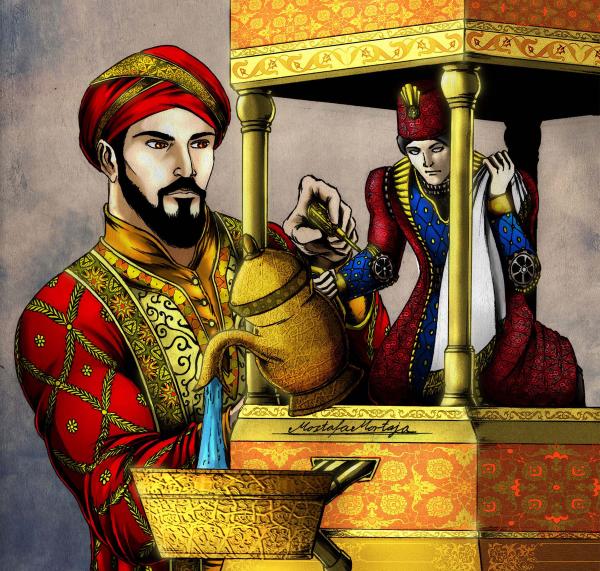 The ablution machine is one of the most innovative inventions of Zaman Jezari
The ablution machine is one of the most innovative inventions of Zaman JezariPeacock fountain with automatic attendants:
Since water and its uses are of great importance in Islam, the influence of this issue can be found in most of the inventions of this scientist. Water is an integral part of the processes of ablution and ablution among Muslims.
An entire section of Al-Jazari's book was devoted to the mechanism of the fountain, entitled “On the Construction of Fountain Basins that Change Their Shapes and Machines for Fluting”. was considered
Tavus Jezari fountain is considered a more advanced washing machine that has robots called servants with the ability to provide soap and towels. Mark Rosheim describes it as follows:
Pulling the appendage on the peacock's tail releases water from the beak. As dirty water from the pond fills the hollow base, the float rises and creates a link that causes a servant figure to appear from behind under the peacock and offer soap. When more water is consumed, the second float moves to a higher level, causing a second maid to appear holding a towel!
Jazari Peacock Spring:
The ablution basin is formed by a peacock fountain, which is operated by an attendant who, after pulling the appendage of the peacock's beak, places it in a position that allows the water mechanism to release it into the basin in front of the user.
In the peacock fountain, the mannequin holds the cup under its beak and when it is full, the flow stops and then it is offered to the person.
Ayhan Aytes says this about this invention:
Many devices also had additional functions that conflicted with divine omnipotence (serving wine). The worst goal of his several hydraulic and pneumatic devices was to get the party guests drunk as quickly as possible.
Camshafts:
In the 13th century AD, for the first time, a rotating rod with a protrusion was used to open and close the valves in the designs of automation and water clocks.
Calibrated blood collection device:
In the Middle Ages, it was very common to take blood from patients, and according to Galen's medicine, it has been prescribed for many diseases based on age, weight, and blood collection season. For this reason, a long line of patients were seen waiting for blood collection, who were constantly present in front of the office, and the doctors were also responsible for taking the exact amount of their blood, which is considered a difficult task.
Tidal automatic blood collector:
Badi-ul-Zaman Jezari designed four types of devices that directed the blood to the bottom vessel, while a weight and a float were balanced by a rope wrapped around a pole. The increase in the amount of blood taken would cause the needle connected to the money to float and move on the upper graduation of the device, finally the nurse could see the amount of blood taken in the unit.
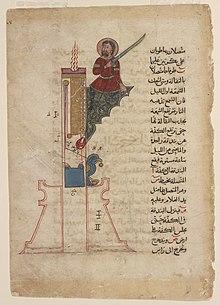 Badi al-Zaman Jezri's book
Badi al-Zaman Jezri's bookGear segment:
In 1206 AD, Badiul Zaman Jezri invented the segment gear for the first time, which was used to convert the rotary motion into a reciprocating motion to draw water. This device is widely used in the industry today.
Crankshaft:
Crank-like designs have been used since ancient Greece, Rome, and Iran to convert linear motion into quasi-rotary motion, for example in hand mills. In the 9th century, Benumosi also used an example of pseudo-cranks, but the first design of today's cranks was designed by Badi al-Zaman Jezari in 1206, in which a two-cylinder water pump was used. 6 centuries later, the use of this device began in steam and then internal combustion engines.
Piston suction water pump:
At the beginning of the 13th century, Badiul Zaman Jezri designed a two-cylinder pump with a contrasting arrangement (Baxter), which had all the parts of a modern pump, such as the valve of the flywheel crank, etc., and could pump water up to a height of 6.13 meters. take away
In addition to the knowledge and techniques of Muslim engineers before him, Jezri designed a number of mechanical and hydraulic tools and devices such as steam engines and internal combustion motorcycles, so that even today the impact of this scientist's innovation can be seen in the science of mechanics.
In Jezri's book, a significant number of Persian words and terms can be found, which indicates the great influence of Iranians in the technology of the Islamic world in the middle centuries.
compilation: Cover biographical section






